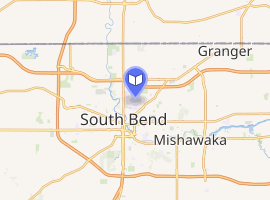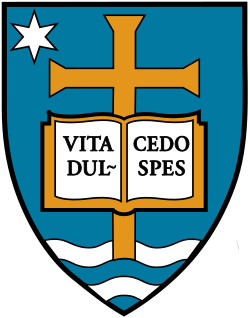Hesburgh Library
Theodore Hesburgh Library is the primary building of the University of Notre Dame's library system. The present-day building opened on September 18, 1963, as Memorial Library. In 1987 it was renamed Hesburgh Library in honor of Rev. Theodore Hesburgh, C.S.C., who served as the university's president from 1952 to 1987. The library's exterior façade that faces the university's football stadium includes a large, 134-foot (41 m) by 68-foot (21 m) mural called The Word of Life, or more commonly known as Touchdown Jesus. As of 2009, the library ranked as the 61st largest collection among research universities in the United States with an estimated 3.39 million volumes.
 The Hesburgh Library, the reflection pool, and the Word of Life mural | |
| Country | United States |
|---|---|
| Type | Academic library |
| Established | 1964 |
| Location | Notre Dame, Indiana |
| Coordinates | 41°42′09″N 86°14′04″W |
| Branch of | Hesburgh Libraries |
| Branches | 9 |
| Collection | |
| Size | 3 million+ books, 3 million+ microform units, 34,000+ electronic titles, 28,850+ audiovisual items |
| Access and use | |
| Access requirements | Students, faculty, and staff |
| Circulation | 329,511 |
| Population served | 14,000 |
| Other information | |
| Budget | $27 million |
| Director | Diane Walker, University Librarian |
| Website | |
| Map | |

| |
| References: [1][2] | |
History
Early libraries
Before the establishment of a library for students, students took the initiative to establish literary societies, that served as the source of literature and discussion of scholarly topics. The first one was the St. Aloysius Literary Society, which was founded in 1850 and six years later established the first student library.[3] It was followed by the Aloysius Philodemics, the Philopatrians and the St Edwards Library Society.
The first circulating library at Notre Dame was created in 1873 by President Rev. Augustus Lemonnier, and incorporate the previously existing student libraries. It was housed on the third floor of the Main Building and its first librarian was Jimmie Edwards, CSC. In 1879 the Main Building was destroyed by fire and 500 books were lost. After the Main Building was rebuilt, a new library was established with a budget of $500 and comprised 16,000 volumes. In 1888, during the golden jubilee of Fr. Edward Sorin, a new library was opened on the third floor. By 1900 it contained 52,000 books. In 1907 the university hired Florence Espy, a professional librarian, to catalog the collection. After the death of Edwards, Paul Foik, came to Notre Dame in 1912 and took over his positions; he pushed for the construction of a library building.
A new building (the present-day Bond Hall) to house the library was built in 1917. It was dedicated during the 75th anniversary of the University, with President William Taft in attendance. By 1920 its collection reached 103,000 volumes. The Dewey Decimal Classification has been used to classify the library's holdings since 1929. Thematic collections were established in other buildings in subsequent decades. A separate engineering library opened in 1933, followed by a biology library in 1938, the Medieval Institute in 1946, and the Nieuwland science library for chemistry, physics, and mathematics in 1953.[4]
Current library
In 1959 Father Theodore Hesburgh, the university's president, announced plans for construction of a new library. Ground was broken in 1961, with the Ellerbe Company of Saint Paul, Minnesota, as the project's architect. Construction took three years. Memorial Library officially opened on September 18, 1963.[5][6]
The finished structure, which is 210 feet (64 m) tall, is built on a site that encompasses 315 square feet (29.3 m2). The interior of 429,780 square feet (39,928 m2) has two lower floors that serve as a base for a narrower and nearly windowless 13-story tower capped with a smaller penthouse. Interior floors have few walls and are supported by bare columns to create a flexible space to arrange stacks of books. The size of the windows was minimized to reduce glare and avoid uneven light from the outside. The two lower floors feature a more extensive use of glass, as well as brick and tweed granite, while the upper floors are finished in Makato stone.[6]
The library's collection reached one million volumes in 1970 and surpassed 1.5 million volumes in 1986.[4] In 1987 the library was renamed Hesburgh Library in honor of Fr. Hesburgh, the university's retiring president, who served as Notre Dame's president for thirty-five years (1952–1987). In his retirement, Hesburgh maintained an office on the library's thirteenth floor, overlooking the Main Quad.[5][7]
As of 2009, the library housed 3.39 million volumes. The Association of Research Libraries ranked it the 61st largest collection among research universities in the United States.[8]
In 2015 the university began major renovations to the library that will modernize its interior design.
Word of Life/Touchdown Jesus mural
The side of the library facing the stadium is covered with a mural called The Word of Life, more commonly known as Touchdown Jesus, that measures 134 feet (41 m) high and 68 feet (21 m) wide.[9]
History
When the library opened in 1963, the mural had not yet been installed. American artist Millard Sheets was commissioned to create a work large enough to cover the entire side of the library facing Notre Dame's football stadium. Fr. Theodore Hesburgh suggested that the theme should be saints and scholars through the ages. The artwork cost $200,000 and was donated by Mr. and Mrs. Howard V. Phalin of Winnetka, Illinois. Installation took place in the spring of 1964; the dedication ceremony was held on May 7, 1964. The mural is composed of 324 panels. It consists of 81 different stones from 16 countries in 171 finishes that includes 46 granites and syenites, 10 gabbros and labradorites, 4 metamorphic gneisses, 12 serpentines, 4 crystalline marbles, and 5 limestones.[10]
Description
The artwork depicts a procession of figures representing Christian saints, thinkers, teachers, and writers, a topic that connected to the idea of the library. Figures were selected from different centuries and places to convey the concept of the Catholic Church's historical continuity. At the top of the procession the central figure is the resurrected Jesus Christ, conceived as the great teacher and master, and the fountain of knowledge contained in the library. The artwork, which is titled Word of Life, is 134 feet (41 m) tall and 68 feet (21 m) wide.
Nickname
The mural's image of Jesus, visible from Notre Dame's football stadium, has arms raised in the same fashion as a referee signifying a touchdown. From this similarity came the mural's nickname, Touchdown Jesus.[11] A stadium expansion partially obscures views of the mural from the field.
Notes
- "Hesburgh Library" (PDF).
- "Hesburgh Library".
- (PDF) http://archives.nd.edu/Scholastic/VOL_0133/VOL_0133_ISSUE_0014.pdf. Missing or empty
|title=(help) - "Chronology of Notre Dame Libraries". University of Notre Dame. Retrieved June 29, 2017.
- Michael O'Brien (1998). Hesburgh: A Biography. Washington, D.C.: Catholic University of America Press. p. 303. ISBN 0-8132-0921-8. See also: "Father Theodore M. Hesburgh". University of Notre Dame. Retrieved June 27, 2017.
- "Theodore M. Hesburgh Library". University of Notre Dame. Retrieved June 27, 2017.
- Hesburgh joined the Notre Dame faculty as an instructor in the religion department in 1945 and was named head of the school’s theology department in 1948. He was appointed as the university's executive vice president in 1949 and succeeded John J. Cavanaugh, C.S.C., as president in 1952. See Linda C. Gugin and James E. St. Clair, eds. (2015). Indiana's 200: The People Who Shaped the Hoosier State. Indianapolis: Indiana Historical Society Press. pp. 169–71. ISBN 978-0-87195-387-2.CS1 maint: extra text: authors list (link) See also: Martin L. McAuliffe Jr. (1970). Profiles of Excellence. Evansville, Indiana: University of Evansville Press. pp. 114–20. OCLC 575784.
- "The Future of Hesburgh Library". The Observer. Notre Dame, Indiana. September 2, 2009. Retrieved June 29, 2017.
- "Romancing the Golden Dome".
- "Hesburgh Library".
- Why Irish eyes are smiling
References
- "Chronology of Notre Dame Libraries". University of Notre Dame. Retrieved June 29, 2017.
- "Father Theodore M. Hesburgh". University of Notre Dame. Retrieved June 27, 2017.
- "The Future of Hesburgh Library". The Observer. Notre Dame, Indiana. September 2, 2009. Retrieved June 29, 2017.
- Gugin, Linda C., and James E. St. Clair, eds. (2015). Indiana's 200: The People Who Shaped the Hoosier State. Indianapolis: Indiana Historical Society Press. pp. 169–71. ISBN 978-0-87195-387-2.CS1 maint: multiple names: authors list (link) CS1 maint: extra text: authors list (link)
- McAuliffe Jr., Martin L. (1970). Profiles of Excellence. Evansville, Indiana: University of Evansville Press. pp. 114–20. OCLC 575784.
- O'Brien, Michael (1998). Hesburgh: A Biography. Washington, D.C.: Catholic University of America Press. ISBN 0-8132-0921-8.
- "Theodore M. Hesburgh Library". University of Notre Dame. Retrieved June 27, 2017.
Further reading
- Stevenson, Marsha. "Style and Symbol: Library Buildings at Notre Dame." In Maureen Gleason, Mareen, and Katharina J. Blackstead, eds. (1994). What Is Written Remains: Historical Essays On The Libraries Of Notre Dame. Notre Dame, Indiana: University of Notre Dame Press. ISBN 9780268019495.CS1 maint: multiple names: authors list (link) CS1 maint: extra text: authors list (link)
- Winkler, Erhard M. (October 1967). "'Word of Life': Stone Mural Dominates Notre Dame Library". Stone Magazine.
